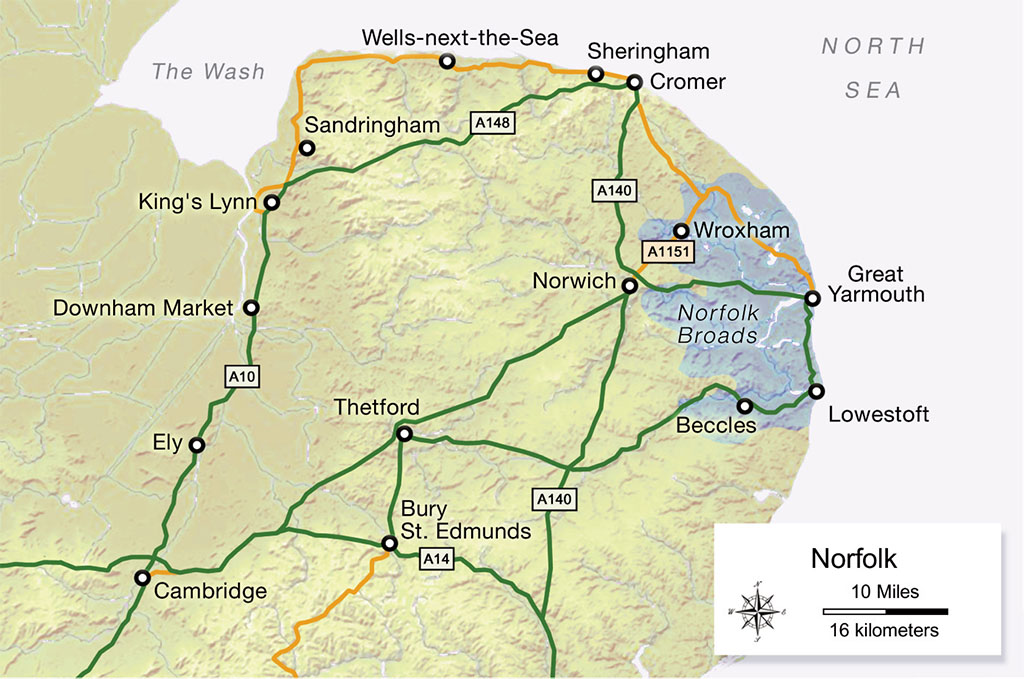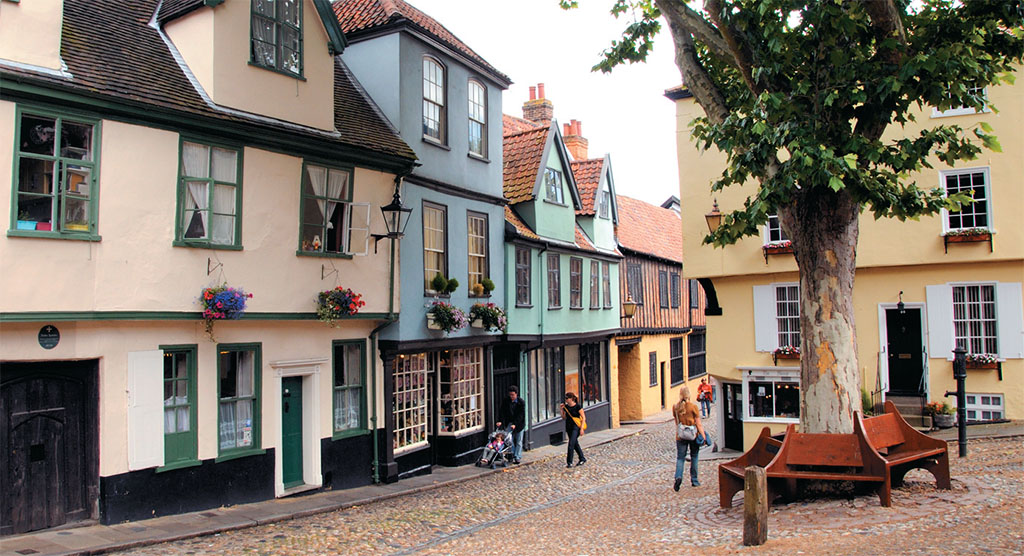
[caption id="ANorfolkPanorama_img1" align="aligncenter" width="1024"]

©TIM GRAHAM/ALAMY
Windmills draining marshy fens, historic cathedrals, cruising the Norfolk Broads, stately homes, medieval market towns and ancient harbors. There is truly something for every taste in this grand regional discovery of Norfolk and The Fens. Little seen by American visitors, Norfolk’s colorful byways and painters’ sky remain free of the hoards of tourist coaches, and beckon for discovery.
Day 1 – Heading to East Anglia
This is a road trip, for sure. If you are setting out from Heathrow, head north on the M25. If you’re beginning at Gatwick, take that M25 orbital road east to the Dartford Crossing. Either way, or from central London, the M11 is the most efficient way to clear metropolitan London heading northeast to East Anglia.
The landscape quickly turns flat and picturesque in its own distinctive fashion. Soon enough, the A11 branches east from the motorway. You might stop in Newmarket, home of English horseracing, to see the National Stud and the National Horseracing Museum. Turning east on the A14, the tiny Suffolk cathedral city of Bury St. Edmunds lies straight ahead. Visit the ruins of 11th-century St. Edmundsbury Cathedral (which was actually completed just a couple of years ago), and do a bit of exploring in the abbey gardens. A few miles north lies the market town of Thetford, also worthy of a good look around.
Make your way, though, on up the A11 to the medieval cathedral city of Norwich. Centrally located, and among the most interesting and compact of England’s old provincial capitals, Norwich boasts many options for accommodation. In the heart of the city, the Maids Head Hotel (Queen Elizabeth I slept here) is perfectly located adjacent to the cathedral precinct in Tombland. The travel website visitnorwich.co.uk can suggest lodging choices for every budget.
Day 2 – Norfolk’s Cathedral City
Once among England’s largest cities and made wealthy with the wool trade, now Norwich prospers as the commercial and political hub of Norfolk. Plan to spend a day just walking the city. The place to start, of course, is regal, 13th-century Norwich Cathedral—with the second tallest spire in England. From the lawns of the cathedral close, it’s a short stroll to the yacht basin on the River Wensum.
Outside the close on Tombland, take a dogleg into medieval Elm Hill, and into the pedestrian precincts of contemporary Norwich. At its heart sits the largest open-air market in England, open daily. Among several othermuseums, don’t miss the famous Mustard Shop and the Bridewell Museum. You won’t be able to miss Norwich Castle rising from Castle Meadow. It is now a terrific museum—both for local history and the celebrated Norwich School of painting. Then, of course, there’s the shopping. This evening, you might drop in at the Adam and Eve pub, opened for cathedral workers in the 13th century.
[caption id="ANorfolkPanorama_img2" align="aligncenter" width="661"]

©PETER COX/ALAMY
[caption id="ANorfolkPanorama_img3" align="aligncenter" width="1024"]

GREGORY PROCH
Day 3 – Visiting the Norfolk Broads
The Norfolk Broads. Today’s excursion is a day of idyllic scenes, medieval stone churches and natural history on the northern rivers: the Bure, the Thurne and the Ant. It’s just a few miles up the A1135 to Wroxham, long known as the “Capital of the Broads.”Wroxhamis a staging town for the popular English holiday known simply as “Cruising the Norfolk Broads”—bustling in the summer and quiet in winter. Take a specially designed Broads cruiser on a holiday on the intersecting six rivers for a few days or a week or more. You might instead catch an excursion boat for a couple of hours river cruise on this unique ecosystem, while grebes and coots paddle alongside.
Anywhere you wander through the Broads is exquisite. Lunch in a quayside pub and watch wildfowl on the reed banks. At a visit to the Broadland Conservation Centre at Ranworth Staith, learn how this manmade landscape came about centuries ago. If you wander north, take in the Horsey Windpump near Hickling Broad. There will be plenty left to do back in Norwich, of course. Catch choral evensong at the cathedral, perhaps, and sample one of local restaurants on cobbled Tombland. Explore the Broads at norfolkbroads.com.
Day 4 – On to Great Yarmouth
There are two ways of doing this day. The distances aren’t great. You can easily enough stay on in Norwich and make Great Yarmouth and the Southern Broads a day trip. Alternatively, you can say farewells to Norwich and plan to stay on the Victorian beachfront in Great Yarmouth.
Either way, today we turn east to Great Yarmouth, where the northern and southern rivers of the Broads network meet. Like many English seaside towns, its waterfront looks a little threadbare in places. But Great Yarmouth is a working harbor as well. It makes an interesting mix. Do visit St. Nicholas Church, reckoned among the largest parish churches in England. Charles Dickens’ holidayed and wrote on the Victorian seafront, and set scenes of David Copperfield along the beach.
The A47 is the direct route from Norwich. Along the way, do stop to see the Stracey Arms Windpump; you won’t be able to miss it. But do get off the highway and explore the lanes of the Southern Broads. Perhaps a route via Reedham. Catch lunch, tea or a pint at the riverside inn. Sit on the terrace and watch the only remaining chain-link ferry carry cars two at a time over the River Yare. The Berney Arms Windmill nearby is a great visit, too.
Day 5 – The North Norfolk Coast
Today we follow the Norfolk coast west under the Wash. It’s a gorgeous drive, well worth the experience. Along the way, there are painful choices to be made; you’ll have to pick one or two visits. From Great Yarmouth, the A149 wends through the Northern Broads to meet the coast at Cromer. From Norwich, the A140 joins the A149 before the coast. A first temptation to stop is Felbrigg Hall, one of England’s finest 17th-century homes, with its original furniture, walled garden and working dovecote. But there are more. At Sheringham, some folk think the English seaside is at its best. There’s also the seal colony and bird sanctuary at Blakeney, and Holkham Hall (see “Lord Coke,” p.46). Admiral Nelson was born in the nearby village of Burnham Thorpe. As the route turns south toward Kings Lynn, you’ll come to the Queen’s private residence of Sandringham. Most of the year, the entire estate is open to the public. It’s a great visit, and another temptation.
[caption id="ANorfolkPanorama_img4" align="aligncenter" width="1024"]

©LOOP IMAGES/GARY SMITH
From King’s Lynn, turn south on the A10 to Cambridge. If time and schedule permit, visit famed Ely Cathedral before continuing on to Cambridge. Across the cathedral close, the home of Oliver Cromwell is a great stop as well. Cambridge has plenty of options for a two-night stay, but don’t arrive here unannounced. visitcambridge.org
Day 6 – Cambridge and the Fens
Once again, you are only spoiled for choices with the day. It’s easy enough to take a walking tour of the ancient university: It’s all around you. Trinity Great Court, King’s College Chapel and 800 years of architecture and tradition are open for view. Explore the warren of Cambridge’s ancient colleges, book stalls, museums and shops. The truly intrepid may try a hand at punting on the River Cam. This afternoon, you may be fully captivated by Cambridge. Alternatively, you might retrace the A10 a few miles to visit Ely and/or the National Trust preserve of Wicken Fen, where the pristine medieval fenland and its way of life are maintained.
[caption id="ANorfolkPanorama_img5" align="aligncenter" width="1024"]

©LOOP IMAGES/IAN MURRAY
Day 7 – Hither and Yon
If you must leave the green and pleasant land, a morning’s drive will have you leisurely to London (but not to an early morning flight). If your adventures can continue, Peterborough, Stamford (see p.26) and the East Midlands are just an hour or two away.





Comments